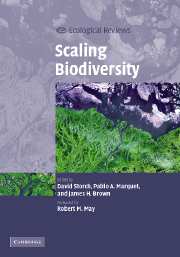Book contents
- Frontmatter
- Contents
- List of contributors
- Foreword by Robert M. May (Lord May of Oxford)
- Preface
- 1 Introduction: scaling biodiversity – what is the problem?
- PART I Spatial scaling of species richness and distribution
- 2 Species–area curves and the geometry of nature
- 3 The distribution of species: occupancy, scale, and rarity
- 4 Species distribution patterns, diversity scaling and testing for fractals in southern African birds
- 5 Geometry of species distributions: random clustering and scale invariance
- 6 Toward a mechanistic basis for a unified theory of spatial structure in ecological communities at multiple spatial scales
- PART II Alternative measures of biodiversity: taxonomy, phylogeny, and turnover
- PART III Scaling of biological diversity with energy and the latitudinal biodiversity gradient
- PART IV Processes, perspectives, and syntheses
- Index
- Plate section
- References
4 - Species distribution patterns, diversity scaling and testing for fractals in southern African birds
Published online by Cambridge University Press: 05 August 2012
- Frontmatter
- Contents
- List of contributors
- Foreword by Robert M. May (Lord May of Oxford)
- Preface
- 1 Introduction: scaling biodiversity – what is the problem?
- PART I Spatial scaling of species richness and distribution
- 2 Species–area curves and the geometry of nature
- 3 The distribution of species: occupancy, scale, and rarity
- 4 Species distribution patterns, diversity scaling and testing for fractals in southern African birds
- 5 Geometry of species distributions: random clustering and scale invariance
- 6 Toward a mechanistic basis for a unified theory of spatial structure in ecological communities at multiple spatial scales
- PART II Alternative measures of biodiversity: taxonomy, phylogeny, and turnover
- PART III Scaling of biological diversity with energy and the latitudinal biodiversity gradient
- PART IV Processes, perspectives, and syntheses
- Index
- Plate section
- References
Summary
Introduction
Describing and ultimately understanding species distribution and biodiversity patterns is undoubtedly one of the major goals in ecology (Gaston, 2000). Spatial scale is an extremely important issue here, and the topic is deservedly now getting more attention than hitherto (for example, Lomolino, 2000; Whittaker, Willis & Field, 2001). There is considerable interest in applying fractal and related cross-scale analytical methods to species distribution patterns, with a view to describing these patterns parsimoniously, connecting cross-scale species incidence with emergent properties such as the species–area relationship (Harte & Kinzig, 1997; Harte, Kinzig & Green, 1999; Plotkin et al., 2000; Harte, Blackburn & Ostling, 2001; Šizling & Storch, 2004; Kunin & Lennon, 2005), predicting abundance at fine scales from coarse scale information (Kunin, 1998; He & Gaston, 2000; Kunin, Hartley & Lennon, 2000; Gaston, 2003), identifying scaling regions and breakpoints (see Hartley et al., 2004) and detecting scale invariance in populations (Keitt et al., 2002). Although the roots of these cross-scale ideas lie partly in more familiar ecological pattern-analysis methods (for a good summary see Dale, 1998; Fortin & Dale, 2005), they offer exciting new ways of describing and thinking about species distribution patterns that may, ultimately, lead to a much better understanding of the ecological processes involved in their generation.
Despite this large and growing body of work, on the whole surprisingly little is known about the scaling properties of species distribution patterns.
- Type
- Chapter
- Information
- Scaling Biodiversity , pp. 51 - 76Publisher: Cambridge University PressPrint publication year: 2007
References
- 9
- Cited by



